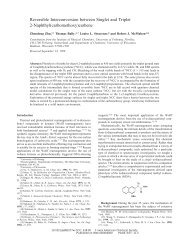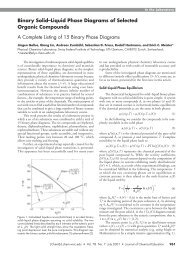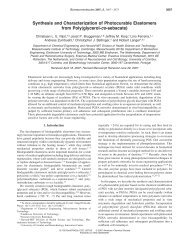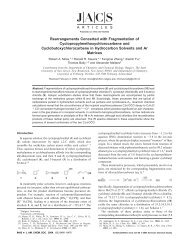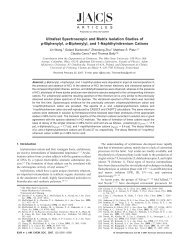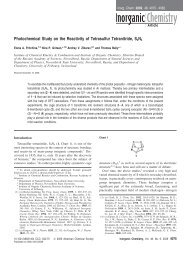Application de la théorie des groupes à la chimie - Département de ...
Application de la théorie des groupes à la chimie - Département de ...
Application de la théorie des groupes à la chimie - Département de ...
- No tags were found...
Create successful ePaper yourself
Turn your PDF publications into a flip-book with our unique Google optimized e-Paper software.
40Si r≠0 on a ε n =ε n mod h et <strong>la</strong> somme: ε r + ε 2r + ... + ε hr se réduit à:ε + ε 2 + ... + ε h =hν=1exp 2πiν/hh= cos 2πν/hν=1h+ i sin 2πν/hν=1= 0 + i0 = 0q.e.d.Cette nouvelle table ci-<strong>de</strong>ssous est équivalente à <strong>la</strong> précé<strong>de</strong>nte.C 5 C 5 C 2 5 C 3 5 C 4 5 C 55=EΓ 1 ε ε 2 ε 3 ε 4 1Γ 2 ε 2 ε 4 ε ε 3 1Γ 3 ε 3 ε ε 4 ε 2 1Γ 4 ε 4 ε 3 ε 2 ε 1Γ 5 1 1 1 1 1Remarque: ε *n = exp(2πin/h) * = exp(-2πin/h) = exp[2πi(h-n)/h]= ε h-nEt, en utilisant l'i<strong>de</strong>ntité ci-<strong>de</strong>ssus, on trouve dans: P.W. Atkins, M.S. Child, and C.S.P. Phillips;"Tables for Group Theory"; Oxford University Press 1970, <strong>la</strong> table suivante:C 5 C 5 C 2 5 C 3 5 C 4 5 C 55=EΓ 1 ε ε 2 ε * ε *2 1Γ 2 ε 2 ε *2 ε ε * 1Γ 3 ε * ε ε *2 ε 2 1Γ 4 ε *2 ε * ε 2 ε 1Γ 5 1 1 1 1 1




